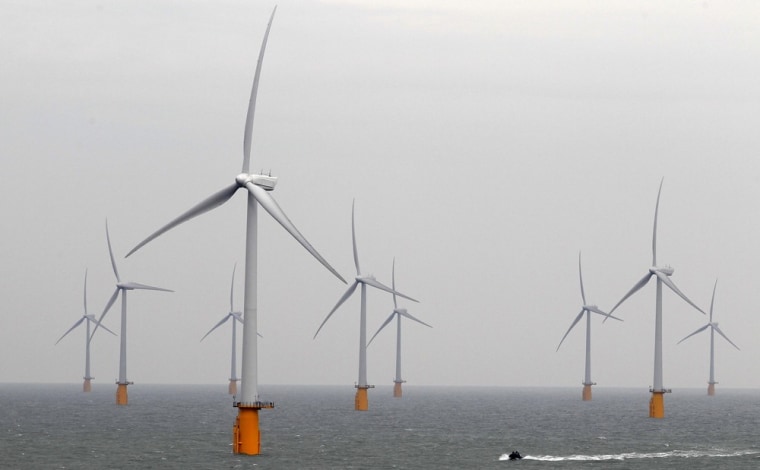The world's largest offshore wind farm had its grand opening Thursday — and its location on the estuary of the Thames River makes it a showcase for Britain's push to move beyond fossil fuels.
So far, 100 wind turbines have been planted in waters up to 80 feet deep across the estuary in southern England. The idea is to produce enough electricity, 300 megawatts, to power the equivalent of 200,000 homes.
Each turbine is nearly as tall as a 40-story building and the blades are at least 65 feet above the water for clearance with vessels. No turbine is closer than 1,600 feet to another and the entire "farm" covers an area of 22 square miles.
Up to 341 turbines will be installed over the next four years.
With Thursday's opening, which tops a 91-turbine farm off Denmark, Britain now has more offshore wind capacity than the rest of the world combined.
"We are in a unique position to become a world leader in this industry," British Energy and Climate Change Secretary Chris Huhne said in a statement before he attended the grand opening. "We are an island nation and I firmly believe we should be harnessing our wind, wave and tidal resources to the maximum."
Britain now gets three percent of its electricity from renewables but aims to get 15 percent by 2020. As part of that, the government this year awarded licenses to wind farm developers in a program that could deliver up to 32 gigawatts of generation capacity and require investment of more than $117 billion.
Critics of the $1.4 billion wind farm include some nearby residents who object to the sight of the giant towers, some visible from shore. The farm starts about seven miles from shore.
Environmental groups tend to back wind power as long as projects are not in areas of significant bird flight paths.
The new wind farm met that standard. It's an "important stride forward," said Craig Bennett of the British chapter of Friends of the Earth.
But the group also wants Britain to guarantee funding of at least $3 billion a year for the recently created and government-funded Green Investment Bank, which aims to boost private-sector spending on low-carbon technology.
"I know that there is still more to do to bring forward the large sums of investment we want to see in low-carbon energy in the U.K.," Huhne said, "and we as government are committed to playing our part."
One embarrassment to the government is that only 20 percent of the investment in the new wind farm has gone to British firms. The farm is owned and operated by Swedish energy company Vattenfall, and the largest chunk of expenditure has been to Denmark's Vestas for the wind turbines.
Global interest
The promised vast expansion of Britain's offshore wind resources is proving to be a powerful lure for companies not normally associated with renewables but keen to generate eco-friendly and reliable sources of revenue.
Engineers, consultants and oil rig makers around the world are setting up new divisions and partnerships in order to get a foothold in the market, which offers secure returns to those building and running the turbines.
"It's attractive for a lot of companies that are looking for contracts," said Ian Simm, chief executive of green fund firm Impax Asset Management, which has holdings in companies such as Vestas.
"The fundamental point that makes it attractive is scale and government commitment, and the fact that industrial companies can learn the facts of success in one offshore environment and be able to transfer the majority, if not all, of those skills to other countries," he said.
However, clearer statements from the government on renewables incentives are still needed to support wind farm developers and really kick-start the market, according to Sarwjit Sambhi, managing director of power generation at Centrica, which has won the rights to develop up to 4.2 gigawatts of offshore windpower in the Irish Sea.
"There is a general theme across this in that we haven't passed the tipping point yet where the industry is confident enough that there is a long-term pipeline of projects."
Britain's potential
The Offshore Valuation Group, made up of government and industry organizations, estimates if Britain were to develop just 29 percent of its potential offshore resource, this could deliver 169 gigawatts of capacity by 2050 and turn Britain into a net exporter of electricity.
This would involve installing 7.2 gigawatts a year — roughly equivalent to 1,000 7.5 megawatt turbines — with fixed offshore wind accounting for 5.4 gigawatts of the average annual build rate needed.
The supply chain needed for this would have annual revenues of nearly $100 billion in 2050 and employ around 145,000 people directly, according to the Offshore Valuation report.
As a result shipbuilders and companies that specialize in making oil rigs are also entering the wind market.
SeaEnergy Executive Chairman Steve Remp, who has worked in the offshore oil and gas market for 30 years, expects the market for equipment vessels to take off at the beginning of 2012.
"I foresee a sizeable industry evolving that calls on the engineering expertise in working offshore in deep water," he said.
